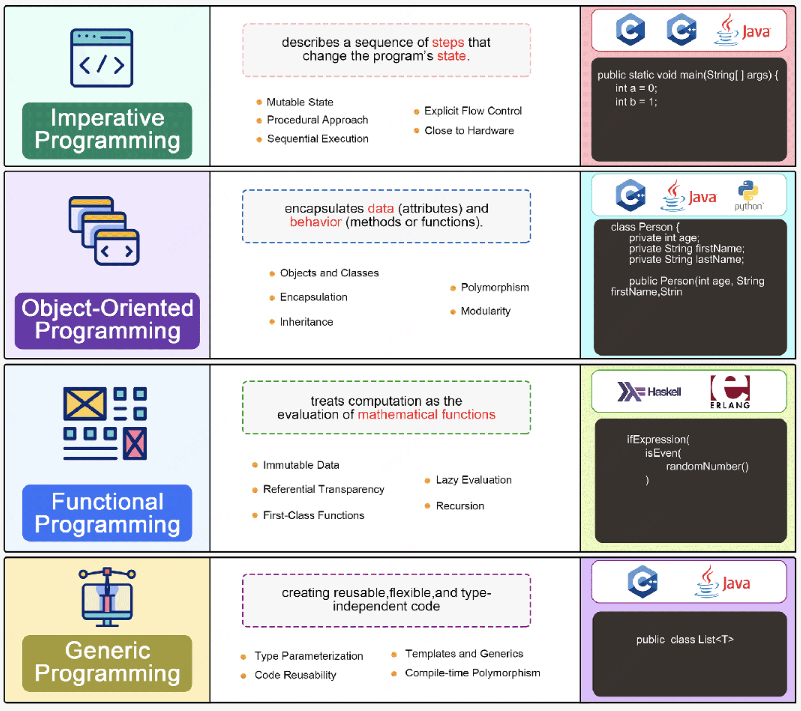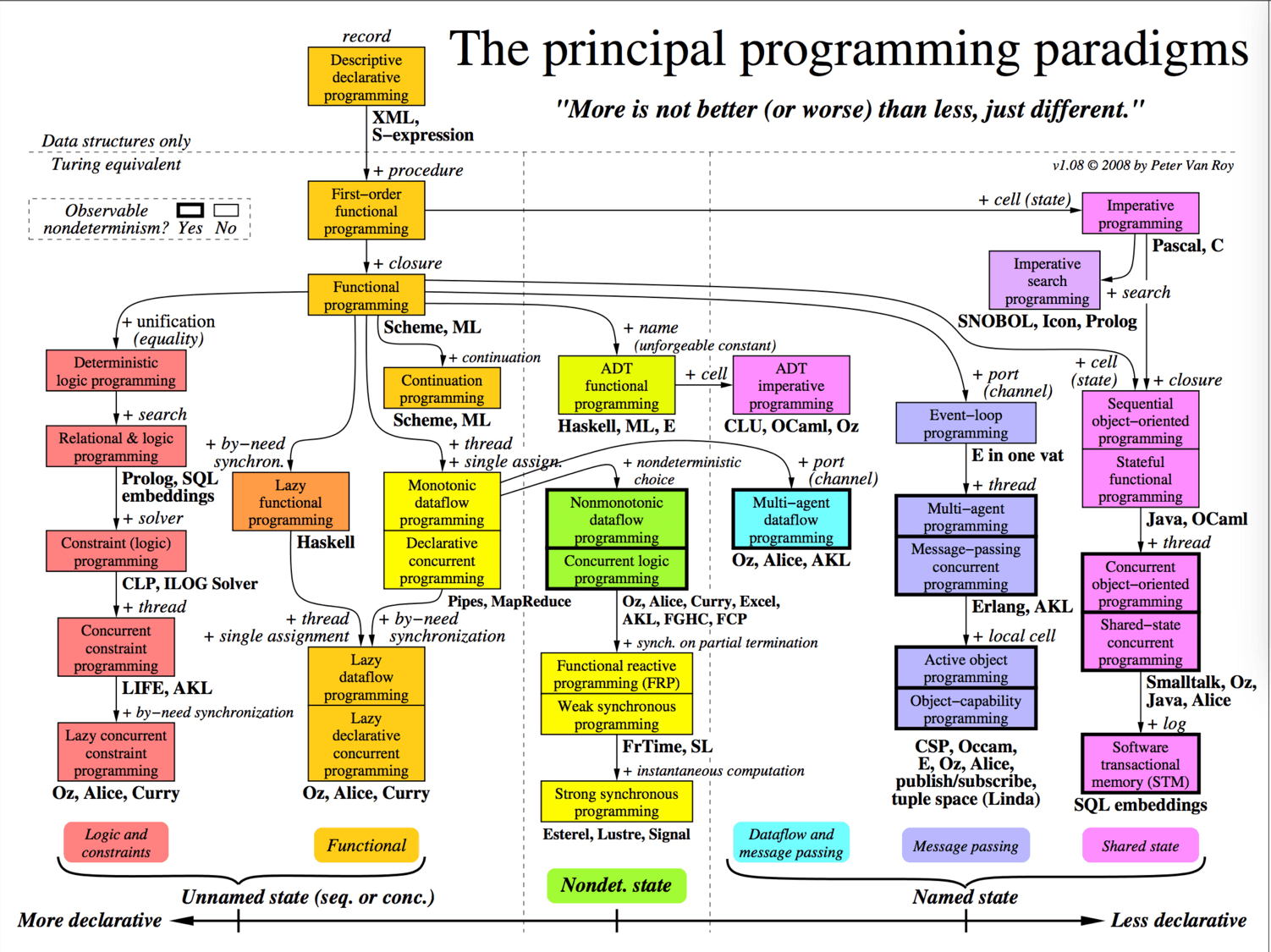专栏预告:编程语言背后的编程范式
 wuzhiguocarter
wuzhiguocarter

在编程的世界里,语言就像是工具箱中的各种工具,每一种都有其独特的用途和优势。为什么我们需要这么多不同的编程语言?它们背后隐藏着怎样的编程范式?在这个专栏中,我们将深入探讨编程语言的多样性、历史背景、相互交互以及未来的发展趋势。无论你是编程新手还是经验丰富的开发者,这个专栏都将为你揭开编程语言背后的奥秘,帮助你更好地理解和选择适合自己的编程工具。准备好了吗?让我们一起踏上这段编程语言的探索之旅吧!
引言
专栏介绍
目标读者与预期收益
编程语言的重要性与多样性
第一章:为什么不能只有一门编程语言?
多样性与专门化
语言的多样性如何促进创新与效率
不同语言为不同领域和问题提供优化解决方案
历史背景与技术限制
早期编程语言的诞生与发展
硬件、操作系统与编程语言的关系
第二章:能否将所有编程语言的优点整合到一门编程语言中?
编程范式概述
过程式编程
面向对象编程
函数式编程
逻辑编程
编程语言的发展简史
早期编程语言(如FORTRAN、COBOL)的出现
面向对象编程语言的崛起(如C++、Java)
函数式编程语言的发展(如Lisp、Haskell)
现代编程语言的多范式特点(如Python、Scala、 Rust)
能否将所有编程范式整合到一门编程语言中?
多范式编程语言的出现(如Scala、Rust)
优势与挑战
第三章:不同的编程语言如何交互?
什么是图灵完备性?
图灵完备性定义
图灵机与计算理论基础
图灵完备的语言具有什么特性?
控制结构(如循环、条件分支)
数据操作(如变量、函数)
不同编程语言如何交互?
语言互操作性的重要性
现有工具与框架(如FFI、语言桥接工具)
序列化与反序列化(如JSON、XML)
API和库的使用
第四章:不同编程语言的源代码如何相互转换?
编程语言的源代码可以互相转换吗?
源代码转换的概念
语言间的语法和语义差异
编译器与解释器的角色
如何转换?
语法树和中间表示
转换过程中的挑战和解决方案
- 实例演示与案例分析(如使用LLVM、Transpiler)
第五章:要开发一门新的编程语言吗?
什么时候需要开发一门新的编程语言?
现有语言的局限性
新需求与新技术的推动
实践中的成功案例(如Go、Rust)
开发过程中常见的挑战与解决方案
如何开发一门新的编程语言?
设计原则与步骤
设计语言语法和语义
实现编译器或解释器
社区和生态系统的建设
结论
专栏总结
编程语言未来的发展趋势
对读者的建议与期望
附录
参考文献与推荐阅读
术语表
常见问题解答 (FAQ)
Column Preview: The Programming Paradigms Behind Programming Languages
Introduction
Column Introduction
Target Audience and Expected Benefits
The Importance and Diversity of Programming Languages
Chapter 1: Why Can't There Be Just One Programming Language?
Diversity and Specialization
How the diversity of languages promotes innovation and efficiency
Different languages provide optimized solutions for different fields and problems
Historical Background and Technical Limitations
The birth and development of early programming languages
The relationship between hardware, operating systems, and programming languages
Chapter 2: Can All the Advantages of Programming Languages Be Integrated into One Language?
Overview of Programming Paradigms
Procedural Programming
Object-Oriented Programming
Functional Programming
Logic Programming
A Brief History of Programming Languages
The emergence of early programming languages (such as FORTRAN, COBOL)
The rise of object-oriented programming languages (such as C++, Java)
The development of functional programming languages (such as Lisp, Haskell)
The multi-paradigm characteristics of modern programming languages (such as Python, Scala, Rust)
Can All Programming Paradigms Be Integrated into One Language?
The emergence of multi-paradigm programming languages (such as Scala, Rust)
Advantages and challenges
Chapter 3: How Do Different Programming Languages Interact?
What is Turing Completeness?
Definition of Turing Completeness
Turing Machine and the foundation of computation theory
What Characteristics Do Turing Complete Languages Have?
Control structures (such as loops, conditional branches)
Data operations (such as variables, functions)
How Do Different Programming Languages Interact?
The importance of language interoperability
Existing tools and frameworks (such as FFI, language bridging tools)
Serialization and deserialization (such as JSON, XML)
Use of APIs and libraries
Chapter 4: How Can Source Code of Different Programming Languages Be Converted?
Can Source Code Be Converted Between Programming Languages?
The concept of source code conversion
Syntax and semantic differences between languages
The role of compilers and interpreters
How to Convert?
Syntax trees and intermediate representations
Challenges and solutions in the conversion process
- Demonstrations and case studies (such as using LLVM, Transpiler)
Chapter 5: Should You Develop a New Programming Language?
When Is It Necessary to Develop a New Programming Language?
Limitations of existing languages
New demands and technological advancements
Successful cases in practice (such as Go, Rust)
Common challenges and solutions in the development process
How to Develop a New Programming Language?
Design principles and steps
Designing language syntax and semantics
Implementing a compiler or interpreter
Building a community and ecosystem
Conclusion
Column Summary
Future Trends in Programming Languages
Suggestions and Expectations for Readers
Appendix
References and Recommended Reading
Glossary
Frequently Asked Questions (FAQ)
Subscribe to my newsletter
Read articles from wuzhiguocarter directly inside your inbox. Subscribe to the newsletter, and don't miss out.
Written by

wuzhiguocarter
wuzhiguocarter
I am a senior software engineer working on DiDi.